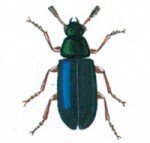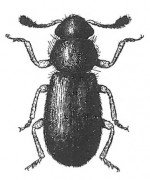Latin: Necrobia rufipes. Also called copra beetle.

The red-legged ham beetle is 4-5 mm long, dark metallic blue with reddish legs. The larvae are up to 10 mm long. They are light grey, but with clear violet drawings on the upper side. In the rear, they have two dark spots. This species is cosmopolitan, probably mainly spread through the trade of copra. Moreover, the larvae develop in many different products: cheese, dried fish, compound feed and various smoked products. They are also found in cocoa beans and figs. The red-legged ham beetle eats carrion. They are sometimes found in museum pieces, and have been found in Egyptian mummies.

The adult beetles are active insects that can fly. They can be more than 1 year old and the females lay 2-300 eggs in a lifetime. The larvae dig into food and it is the larvae that eat the most. Adult beetles also eat. When the larvae are fully grown, they seek out the cracks and crevices in whatever they have lived in or nearby, and here they pupate in white, papery cocoons. At the preferred temperature, 22 ° C, development from egg to adult lasts just over a month. At temperatures below 9 ° C reproduction stops completely.
Outdoors in Northern Europe, the beetles only produce one generation per year. In warehouses and factories red-legged ham beetles especially infest compound feed, fish and bone meal, as well as milk and egg powder.




